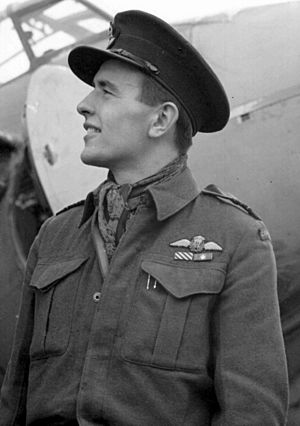Russell Bannock facts for kids
Quick facts for kids
Russell Bannock
OOnt DSO DFC*
|
|
|---|---|

Bannock in October 1944
|
|
| Birth name | Russell William Bahnuk |
| Nickname(s) | Russ |
| Born | November 1, 1919 Edmonton, Alberta, Canada |
| Died | January 4, 2020 (aged 100) Toronto, Ontario, Canada |
| Allegiance | |
| Service/ |
Royal Canadian Air Force |
| Years of service | 1941–1945 |
| Battles/wars | World War II |
| Awards |
|
| Other work | Aviator and test pilot |
Russell William Bannock (born Bahnuk) was a brave Canadian fighter pilot during World War II. He was also a very important test pilot for a company called de Havilland Canada. Russell was born on November 1, 1919, and lived to be 100 years old, passing away on January 4, 2020.
Contents
Early Life and Flying Dreams
Russell Bannock was born in Edmonton, a city in Alberta, Canada. Even before World War II began, he loved flying. He earned his private pilot's license in 1938. The next year, in 1939, he got his commercial pilot's license. This meant he could fly planes for a job.
Becoming a War Hero
When World War II started, Russell joined the Royal Canadian Air Force (RCAF) in 1941.
Training and Teaching Pilots
In 1940, Russell earned his pilot's wings, which meant he was officially a trained pilot. He then became an instructor at Trenton, Ontario. He taught other pilots how to fly. For a short time in 1942, he worked with the RAF Ferry Command. This group delivered planes across the ocean. Later in 1942, he became the chief instructor at a flying school in Arnprior, Ontario.
Fighting in Europe
Russell really wanted to join the fight overseas. His wish came true in 1944 when he went to England. He joined No. 418 Squadron RCAF. This squadron flew de Havilland Mosquito planes. These were fast fighter-bombers used for "intruder missions" over Europe. This meant they would fly into enemy territory to attack.
Russell quickly became very good at these missions. He shot down his first enemy planes. In October 1944, he was promoted to Wing Commander. This was a big leadership role, and he took charge of his squadron.
Stopping Flying Bombs
Russell also flew special missions called 'Diver' operations. His job was to stop German V-1 "flying bombs". These were early missiles launched towards London and southern England. On one amazing mission, he shot down four V-1s in just one hour! Because of his bravery against the V-1s, he received a special award called a bar to his Distinguished Flying Cross (DFC).
In November 1944, Russell became the commanding officer of No. 406 Squadron RCAF. He was also awarded the Distinguished Service Order (DSO) for his outstanding service. By April 1945, Russell Bannock had destroyed 11 enemy aircraft. He also damaged 4 more in the air and shot down 19 V-1 flying bombs. After the war, in May 1945, he became the Director of Operations for the RCAF Overseas Headquarters in London.
Life After the War
Russell left the RCAF in 1946. He then started a new career with the de Havilland Canada Aircraft Company.
Becoming a Chief Test Pilot
At de Havilland Canada, Russell became the chief test pilot. This meant he was the first person to fly new planes they built. He flew important prototype aircraft like the Beaver. These planes were known for being able to take off and land in very short distances.
Later, in 1950, Russell became the Director of Military Sales for the company. He then moved up to Vice President and eventually President from 1976 to 1978. In 1968, he also started his own company, Bannock Aerospace Ltd.
Honors and Legacy
Russell Bannock received many honors throughout his life. In 2011, he was made a member of the Order of Ontario. This award recognized his important work in the aerospace industry.
Russell Bannock was a true hero, both in the skies during the war and in helping to develop new aircraft after it. He passed away in Toronto in January 2020, at the age of 100.

